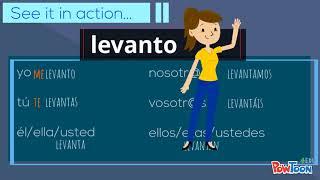Комментарии:

my spanish test is tomorrow, I was so lost when it comes to the sentence structure and this made it all make so much more sense entonces gracias 🥹🫶🏾
Ответить
Thanks for shining a light on reflective verbs
Ответить
bad vid
Ответить
I really need to get extra spanish classes😭
Ответить
Can someone explain it was me cepillo los dientes? What was the purpose of adding the definite article “los”? Thanks
Ответить
¡Muchas Gracias. Aprendimos mucho de su video excelente! Pero, es mejor usar los puntos al fin de las frases.
Ответить
Finally I understand! The llamo llamarse explanation finally cleared it up for me, thank you!!
Ответить
Thank you so much!!! I was struggling with this all week and it finally clicked that I add the reflexive pronoun AND conjugate the ar/er/ir verb (after removing se). Thank you thank you thank you. ❤
Ответить
so.... "Go f*ck yourself" is "te chingas" ??
Ответить
Great video but there are a couple of mistakes. Despertarse is spelled wrong on the screen.
Ответить
May tay say hahaha
Ответить
Despertarse no despartarse, would be nice to make that correction.
Ответить
I've struggled with this for three years. Most teachers do what you do.
But surelt "me llamo" is just an ordinary verb, following the ordinary order of words in Spanish. "Te llamo" is "I call you, but it's not reflexive. The reflexivity is therefor in the direct object pronoun, not in the verb. It's not a "a reflexive verb", it's a "sentence reflecting an action the the doer of the action". Right?

this video was awful i hated it
Ответить
thank you, got a quiz tomorrow.
Ответить
Gracias 🙏
Ответить
This is the best reflexive verb explanation I've ever seen. It's simple, effective, and covers all the important points. GRACIAS
Ответить
Thank you.
Ответить
Great video!! I have a question. I was working with reflexive verbs an I was getting the hang of it. Then I came across this sentence, "Después de levantarme, me afeito la cara". Why wouldn't this sentence be "despues de me levanto" ?
Ответить
Thanks!
Ответить
this was great
Ответить
Let's learn Spanish. ! Vamos aprende espanol!
Ответить
OMG, where were you in Spanish 2 when I needed you? I remember being so confused when my teacher tried to explain it but you make it make sense. I like how your voice is calm. That helps me.
Ответить
my spanish teacher just told us "these are reflexive verbs" and gave us a worksheet without telling us how to use them so this was very helpful thanks!
Ответить
I've watched many videos and this is by far the best one out there! thank you!
Ответить
Muy bien!
Ответить
mucho gracias
Ответить
great video
Ответить
you deserve an award for this video
Ответить
Question, why when we say me gusta or te gusta why doesn’t the gusta change?
Ответить
Thank you!! At last!!
Ответить
THANK YYYYYYYYYYOOOOOOOOOOOOOOOOOOOOOUUUUUUUUUUU SSSSSSSSSSSOOOOOOOOOOOOOOOOO MMMMMMMMMMMMMUUUUCCCCCCCCCCCCHHHHHHHHHHHHHHHH
Ответить
Excellent video and explanation. ¡Gracias!
Ответить
This video is incredibly helpful! Thank you so much you have saved me
Ответить
When can we use these verbs in infinitive form ? I'd love to get some examples. I'm a bit puzzled even why we need infinitive form - most of those are just regular verbs that are used in a peculiar reflexive way. Can any verb be reflexive under right cirunstances? Please clarify.
Ответить
Thid was amazing!! Thank you so much
Ответить
Thank you, you make it a lot easier than school does
Ответить
thank you this video was very helpful!
Ответить
Thank you for this video. However my Spanish friends say that 'cepillo mis dientes' is also correct, even if 'me cepillo los dientes' might be more common.
Ответить
Thank you
Ответить
What an amazing video, I feel inspired to make some material now. Me toca a mí
Ответить
hello
Ответить
Show more por favor
Ответить
this looks like fortnite
Ответить
this looks like fortnite
Ответить
I forgor 💀
Ответить
Ong I learned more than what my teacher could teach 💀💀
Ответить
thanks for the video
Ответить


























